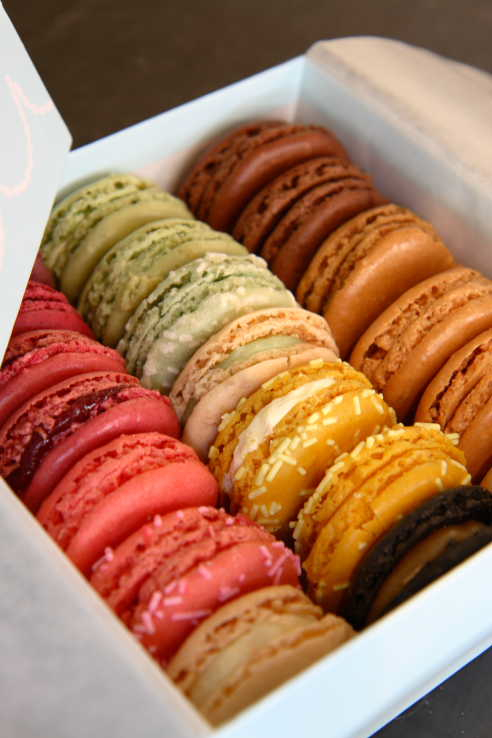David Downie: Artful Parisian Pastry: Paris Past, Part 1
by David Downie
What do the glories of ancient Greece and imperial Rome, baroque Naples and pre-revolutionary “Let-them-eat-cake” France have in common with contemporary Paris?
Easy: artful pastry.
Toss out a euro coin nowadays and it will probably land on a Paris pâtisserie whose chef is bent on titillating customers’ taste buds while dazzling eyes and lightening wallets. White chocolate roses crown red powdered-sugar lips. Fruit still-lifes à la Caravaggio top praline plinths. Dark chocolate treasure chests enclose luscious layer cakes, and bras are not of silk but of purest chocolat.
Training in artistic Parisian pastry making is also in vogue: ever since the renowned École Grégoire-Ferrandi cooking school began partnering with mega-star Pierre Hermé, the chef Vogue has dubbed “the Picasso of pastry”, the “Haute Pâtisserie” concept has ruled Paris tastes.
“The fine arts number five,” wrote Marie-Antoine Carême in the late 18th century, “painting, sculpture, poetry, music and architecture, the principal branch of which is pastry.”
Ever the tongue-in-cheek wit, not for nothing Carême was known as “the king of chefs and the chef of kings”. His claim to pastry fame was the invention of Pièces Montées—precursors of today’s tiered wedding cakes. Remember Tony Curtis and Marilyn Monroe in Some Like it Hot? Carême pièces were big enough to hide a man, like the cakes machine gun-toting Mafiosi burst from in gangster movies.
Ephemeral, edible architecture is much older than Some Like it Hot or even Carême, however. The word “pastry” (pâtisserie in French) comes from the Latin “pasta”. Today’s pastry artworks look positively minimalist compared to the wild fantasies of the past. No one fills giant pastry shells with live birds anymore, as some Romans did for a lark in the days of imperial decadence. I haven’t encountered many chef pâtissiers building fifteen-foot Neapolitan Trionfi sugar-and-pastry sculptures either, or parading them around town, then tossing them to the famished rabble in the style of Naples’ lovable Bourbon kings.
The artistic, extravagant dimension of pastry isn’t new. But does head pastry chef Philippe Andrieu of venerable Ladurée realize he’s carrying on a tradition that goes back to the pyramidalpyramous pastries described by Callimachus over 2,000 years ago?
Pyramid pastries came back into fashion in Paris during the Second Empire (1852-1870) about the time Ladurée invented the cream-filled macaron. Chef Andrieu oversees the construction of delectable macaroon pyramids today. That’s not to say he’s behind the times: pyramids or not, Andrieu dreams up fanciful seasonal macaroon flavors—orange, chestnut, almond or licorice for winter, violet-currant, coconut, lime-basil or glacial mint for summer. With a wink to surrealist Salvador Dalì and fashion designer Elsa Schiaparelli, Andrieu once fashioned a molded dessert of smiling red lips from vanilla pastry cream, mango compote, raspberries, passion fruit and coconut, poised atop a tender pastry biscuit.
Practical Information
Ladurée Champs Elysées
75, avenue des Champs Elysées – 75008 Paris
Tel.: 01.40.75.08.75 – Fax : 01.40.75.06.75
Métro: 1, George V
RER: Charles de Gaulle-Etoile
Bus: 73, 32, 92
Vélib: 16, rue de Lincoln
Click here for other Ladurée locations in Paris.
About the author: David Downie moved from San Francisco to Paris in the 1980s. His travel, food and arts features have appeared in magazines and newspapers worldwide. He’s the author of two thrillers and a dozen nonfiction books, including Paris, Paris: Journey into the City of Light (Random House, April 5, 2011), Quiet Corners of Rome (The Little Bookroom, April 26, 2011), and his latest, Paris to the Pyrenees: A Skeptic Pilgrim Walks the Way of Saint James He is a regular contributor to The Rambling Epicure, covering food, wine and travel in France and Italy.
Story photographer credit: Images copyright ©Alison Harris, photographer of Patisseries of Paris (The Little Bookroom).
This article was originally published on BonjourParis and is reprinted with the authorization of David Downie and Alison Harris._atrk_opts = { atrk_acct:”vvoMh1aIE7000g”, domain:”theramblingepicure.com”,dynamic: true};
(function() { var as = document.createElement(‘script’); as.type = ‘text/javascript’; as.async = true; as.src = “https://d31qbv1cthcecs.cloudfront.net/atrk.js”; var s = document.getElementsByTagName(‘script’)[0];s.parentNode.insertBefore(as, s); })();
![]()
|
|





















